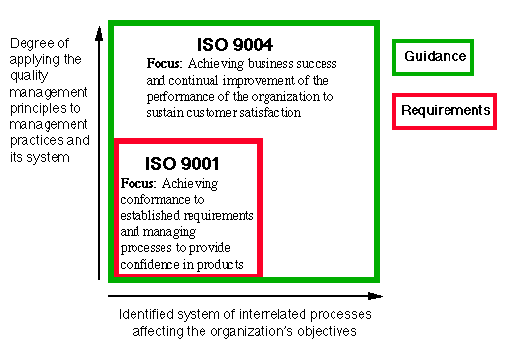| Principle |
ISO 9001 |
Beyond ISO 9001 |
|
| Customer-Focused Organization |
Assure conformance to defined customer requirements.
Ensure effective response to customer feedback. |
Understand current and future customer needs and
expectations. Address customer loyalty. Measure customer satisfaction and
act on it. |
|
| Leadership |
Set and deploy policy and verifiable objectives,
provide resources and establish an environment for Quality. |
Establish vision, direction and shared values. Set
challenging goals and implement strategies to achieve them. Coach, facilitate,
and empower people. |
|
| Involvement of People |
Establish competency levels, train and qualify personnel.
Provide clear authority and responsibility. |
Create personal ownership of an organizations goals,
by using it's peoples knowledge and experience, and through education achieve
involvement in operational decisions and process improvement. |
|
| Process Approach |
Establish, control and maintain documented processes.
|
Explicitly identify internal/external customers
and suppliers of processes. Focus on use of resources in process activities,
leading to effective use of people, equipment, methods and materials. |
|
| System Approach to Management |
Establish and maintain a suitable and effective
documented Quality Management System. |
Identify a set of processes in a system. Understand
their interdependencies. Align the processes with the organizations goals.
Measure results against key objectives. |
|
| Continual Improvement |
Through management review, internal/external audits
and corrective/preventive actions, continually improve the effectiveness
of the Quality Management System. |
Set realistic and challenging improvement goals,
provide resources and give people the tools, opportunities and encouragement
to contribute to continual improvement of processes. |
|
| Factual Approach to Decision Making |
Management decesions and actions on the Quality
Management Systems are based on the analysis of factual data and information
gained from reports on audits, corrective action, nonconforming products,
customer complaints and other resources. |
Decisions and actions are based on the analysis
of data and information to maximise productivity and to minimise waste and
rework. Effort is placed minimising cost, improving performance and market
share through the use of suitable tools and technology. |
|
| Mutually Beneficial Supplier Relationships |
Adequately define and document requirements to be
met by sub-contractors. Review and evaluate their performance to control
the supply of quality products and services. |
Establish strategic alliances or partnerships, ensuring
early involvement and participation defining the requirments for joint development
and improvement of products, processes and systems. Develop mutual trust,
respect and commitment to customer satisfaction and continual improvement.
|

